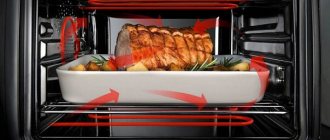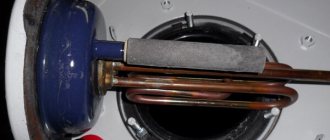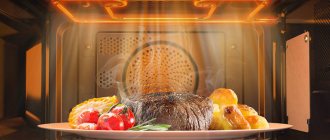The “Reverse” button on the meat grinder is indicated by the “R” icon
Absolutely every housewife uses such a kitchen appliance as a meat grinder. But not every housewife can answer this question: what is reverse? The translation of the word “reverse” is the reverse move. This function was found even in mechanical meat grinders. But is this function so necessary? Is reverse necessary in a meat grinder? Let's try to figure this out. Every lover of delicacies has in his kitchen a large number of devices and appliances that make cooking easier. To chop vegetables, fruits or berries, you can use various kitchen tools. But in order to cook minced meat correctly, you cannot do without a meat grinder. Today, in almost every home, electrical devices have been replaced by manual ones. Thanks to electrical devices, the preparation of minced meat is carried out quickly and efficiently. You can save your energy and time. The cooking process becomes a real pleasure for the housewife.
Electric meat grinders have a number of advantages:
- They do not need to be attached to the table.
- The receiver has a long neck. The pusher fits easily here, which makes the device safe.
- The procedures are much easier to perform, since they are more powerful than manual instruments.
- Suitable not only for grinding meat, but also for other purposes.
- The veins are not particularly difficult. Thanks to the reverse function, you can easily clean clogged spaces.
Let's now talk separately about the reverse system. Is there a need for it? What exactly is reverse in a meat grinder?
Why do you need a reverse function in a meat grinder?
First, you should understand the principle of operation of the meat grinder itself. The auger, which moves pieces of meat to the exit, is equipped at the end with a special cross-shaped knife, which chops the products. Next, the chopped meat is pressed through the grate to form minced meat.
Meat of low quality, containing veins, rough fascia, not everything can be ground. Often there are long, stiff fibers left behind that have no choice but to wrap around the rotating shaft. This reduces the speed, increases the load on the meat grinder, which ultimately can lead to shutdown due to overheating. There is only one way out: periodically turn off the device, disassemble it and remove everything unnecessary from the auger and knife. Reverse is very helpful in such a situation.
Stringy meat can get stuck in the grinder
Reversing diagram of a three-phase motor in a single-phase network
Since a three-phase asynchronous motor will lack two phases, they need to be compensated with capacitors - starting and running, to which both windings are switched. The torsion of the shaft in one direction or another depends on where to attach the third.
Read also: Why does a chainsaw stall at idle?
The diagram below shows that winding number 3 is connected through a working capacitor to a three-position toggle switch, which is responsible for the forward/reverse engine operating modes. Its other two contacts are combined with windings 2 and 1.
When turning on the engine, you must adhere to the following algorithm of actions:
- Apply power to the circuit through a plug or switch.
- Move the toggle switch to switch operating modes to forward or reverse (reverse).
- Set the power switch to the ON position.
- Press the “Start” button for a time not exceeding three seconds to start the engine.
Reverse operating principle
Reverse is the reverse movement of the shaft, which allows you to solve the problem of winding the cores on the auger . His task is not to let the veins pass so far that they wrap around the knife. To do this, the contents of the shaft are returned a certain distance back by reversing the stroke. After this, the device is given a second chance to deal with the stubborn piece of meat. Depending on the type of meat grinder, the reverse may be different.
Reverse in mechanical (manual) meat grinders
We are talking about simple manual meat grinders, which at one time were in almost every home. The shaft rotation is carried out manually. The user rotates the handle, the force from which is transmitted to the free end of the auger. The auger moves synchronously with the handle. This is a very simple mechanism. Reverse, that is, a change in the direction of movement of the shaft, occurs when the direction of rotation of the handle changes.
Attention! The main working movement in a mechanical meat grinder is clockwise. Accordingly, if reverse is needed, the handle must be rotated counterclockwise.
As a result of such actions, the veins from the knife and screw will unwind, and everything that is in the meat grinder will return through the auger back into the loading tray. Here you can select the tendons and send the rest back for processing.
Reverse in electric meat grinders
Both forward and reverse motion in an electric meat grinder occurs without user intervention, in automatic mode. The hostess only needs to give the desired command (using the reverse on/off button).
Physically, the function is implemented in the same way as in mechanical models. The shaft begins to rotate in the opposite direction, moving the products towards the loading tray, freeing the knife and auger from the stuck veins. The direction of rotation changes automatically when a certain button is pressed.
Manual meat grinder
In a manual meat grinder, the reverse is the driving force of the hostess’s hand
As we know, the main purpose of this kitchen appliance is to grind meat. It happens that during this process some problems may arise. For example, if the meat is poorly cleaned of bones, veins, or cut large enough, all this can lead to the space between the knife and the grate becoming clogged. There is a twist on the screw, which leads to complications in processing. Ultimately, the process may stop altogether.
So, if the reverse function were absent, the device would have to be constantly disassembled and cleaned. But there is a reverse move. On a manual machine, you just need to scroll the handle in the opposite direction, after which you can pull out the unscrolled meat product. You can continue with the complex manual chopping of meat!
Advantages of an electric meat grinder with reverse function
Electric models equipped with a reverse function have a number of advantages over their mechanical counterparts.
- Making minced meat, forming sausages and other operations become fast and can be done just by pressing a button, rather than turning a crank for hours.
- The veins are removed from the knife themselves during reverse. There is no need to disassemble the device.
- For minced meat, you can use raw materials of any quality. There is no need to clean it as thoroughly as for a manual meat grinder. All cores can be removed during the process using reverse.
- Reverse ensures uniform operation of the device, without “stressed” areas. Thanks to this, knives become less dull.
- This type of meat grinder is easier to maintain.
- Since there are no situations when the device cannot cope, it works at the limit, the service life as a whole increases.
Thermal relay RTK-S.
Washing machines use thermal (protective) relays RT-10 and start-up protection relays RTK-S, RTK-1, RTK-1-3, RTK-3-O, etc. The thermal relay type RT-10 with one normally closed contact is used for overload protection of electrical installations and single-phase AC electric motors with rated voltage up to 220 V. Relays are manufactured for rated currents In thermal elements 1.2; 1.9; 2.5; 3.3 and 4.3 A. At In = 1.1 A, the relay does not operate for 30 minutes; at In = 1.35 A, the relay operates in no more than 30 minutes; at In = 2 A the relay operates in 18...60 s. The time for the contacts to return to the closed state is from 30 s to 10 min. The relay has a built-in bimetallic thermocouple with a reversible spring, which ensures instantaneous opening and closing of contacts. The relay insulation can withstand a test voltage of 2000 V applied for 1 minute. The relay is installed in a vertical position with the contacts facing up, power is supplied to the top terminal. The relays are designed for operation in enclosed spaces at ambient temperatures from 0 to 70°C. This is quite effective protection. So don’t neglect it, otherwise it will be more expensive for yourself. Well, what else, that's all for now. Good luck everyone. Goodbye. K.V.Yu.
[1] Radio 2004 No. 6 p.42 Burkov V. “How to connect a 127V motor to a 220V network.”
Is it possible to do without reverse?
It is quite clear that if minced meat is prepared from sirloin, a device of any power will cope with this task. But the housewife is not always able to clean the product from tendons and seeds well. And in the absence of reverse motion, work will be difficult.
Some models of devices have special safety devices to prevent bones and veins from entering the apparatus, but in such cases overheating of the mechanisms can often be observed, which sometimes leads to their breakage . Therefore, manufacturers prefer units with reverse motion.
Although it is believed that low-power devices, from 1000 to 1800 W, need reverse rotation, and high-power devices can cope without it, increasingly devices with a power of 1800 W or more are made with reverse rotation.
Obviously, reverse has an important property. Its use simplifies the process of rolling meat, and many modern brands are equipped with a reverse system. But the presence of such a function is reflected in the cost of the unit. Consider carefully whether you will be using meat with stringy fibers, fish with skin, or vegetables and fruits with skin. If not, then you don’t have to overpay for a meat grinder. It should be taken into account that such household appliances are purchased infrequently. Therefore, you need to be careful when purchasing, with a view to the future, and still choose a model with auto reverse.
Required Components
Independently connecting the motor for reverse rotation will not cause any particular difficulties if you follow the diagram provided. One of the important components that will facilitate this task is a magnetic starter or contactor. In fact, a magnetic starter and a contactor are not identical concepts. To put it simply, the contactor is part of the magnetic starter, but for simplicity, in the article both concepts are used as equivalent. Magnetic starters are precisely used for starting, reversing and stopping asynchronous motors.
Read also: Corner for kitchen furniture
Perhaps the question arises as to why you can’t use a regular switch or power circuit breaker. In principle, this is acceptable, but the starting currents that the engine needs for normal operation are not always safe for humans. When switched on, a breakdown may occur, which will damage both the switch and harm the operator. To minimize risks, you will need a starter. In it, the contact part is separated from the one with which the operator interacts. It contains a separate module with a coil that creates an electromagnetic field. The coil may require 12 volts or more to operate. When this voltage is applied, it interacts with the metal core, which is pulled into the coil. A plate is attached to the core, which goes to the contact group. They close and the engine starts. Stopping occurs in reverse order.
In addition to the contactor, you will need a three-button station. One key performs the stop function, and the other two start functions with a difference in the direction of rotation. A three-button station must have two normally open contacts and one normally closed. Simply put, the normal position of the contactor is its non-operating position. That is, when a contact is acted upon, it either closes or opens. If in operating condition it is closed, it is designated as NO, and if it is open, it is designated as NC. The NC contact is used for the stop button.
Tcall function, Transmitter power selection
Page 33
- Image
- Text
1. Click the button
on the top panel to select the SQL LEVL function.
2. Press the button
.
3. Rotate the DIAL knob to reduce the noise level until the screen turns green
BUSY indicator.
Selection: Amateur Range:
AMFM broadcast band:
If you continue to turn the DIAL clockwise, the sensitivity to weak channels decreases.
4. Press the button
to save the new settings and return to VFO or Channel mode
memory.
If the button
set to SQL LEVL function via top panel buttons
, then the button
can be used as a level adjustment button
noise.
TCALL function
Enable 1750 Hz Tone Sends (Disabled by Default) You can enable the TCALL feature if repeaters in your country require 1750 Hz Tone Sends to be activated.
1. Click the button
on the top panel to select the TCALL function.
2. Press the button
.
The transmitter is automatically activated and a 1750 Hz audio tone is applied to the media.
3. You can release the button
and use the PTT button for subsequent activation
transmitter.
Transmitter power selection.
Select the appropriate transmitter power level to reduce battery drain and use the minimum power to maintain reliable communications.
1. Click the button
on the top panel to select the TX POWER function.
2. Press the button several times
to select the required transmitter power level.
You can set the transmitter power level separately for the 144 MHz and 430 MHz bands.
33
Why does a meat grinder crush meat?
The reason why a meat grinder may not grind meat well may lie in the product itself. Experienced housewives recommend choosing meat without veins. They still won’t be able to grind, but will only screw onto the metal shaft, preventing other meat from grinding. If you have already purchased such a product and you need to grind it, you should clean the device from the veins more often. After cleaning, you can start grinding again, removing all unnecessary elements.
Many housewives know that a meat grinder chews soft, too melted meat. It is recommended to grind a product that is not completely defrosted. This will make the knives cut easier and better.
And, of course, it is better to initially purchase good meat intended for making minced meat. Before processing it must be cut into small pieces.
Properly selected meat is the key to high-quality work of the meat grinder
Before chopping meat, be sure to remove all cartilage and bones. They will not only prevent the product from being properly chopped, but will also become an unpleasant surprise in an already prepared dish.
How to distinguish a reversing starter from a direct one
A reversing starter is a more complex device. In fact, it consists of two conventional direct starters, the latter combined in one housing. The internal circuitry of the reversing device is characterized by the fact that it is impossible to run two modes at the same time - direct and reverse. This process is controlled by a blocking circuit, which can be electrical or mechanical.
Electric meat grinder device
This kitchen appliance is designed quite simply. Inside the housing (1) there is a motor that rotates the meat grinder shaft through a gearbox. Most devices have a gearbox that is partially or completely plastic, and it is wear or breakage of the plastic parts of the gearbox that is the most common reason for a meat grinder to fail. In expensive models, the gearbox is made entirely of metal, and to protect the engine when wedged on the shaft, a safety clutch is installed. The auger (2) of the meat grinder is fixed to the shaft, and as it rotates, it pushes the meat through the meat receiver (3). The meat enters the meat receiver through the tray (4). At the end of the auger there is a knife (5) and a perforated steel disk (6), pressed with a clamping nut (7). The meat enters under pressure into the holes of the disk and is cut off by a moving knife. High-quality discs and knives of expensive meat grinders ensure easy cutting of meat without unnecessary deformation and low load on the engine - as a result, the minced meat is of higher quality and the productivity of the device increases. Budget models of meat grinders are often equipped with knives and discs made of cheap steel, which require frequent sharpening.
Starting the motor with a star-delta circuit
When directly starting powerful three-phase electric motors using a reverse control circuit, voltage drops occur in the network. This is due to the large inrush currents flowing at this moment. To reduce the current value, use a gradual start of the motor according to the star-delta circuit.
The bottom line is that the beginning and end of each stator winding are led out into a terminal box. The circuit is controlled by three contactors. They gradually turn on the windings in a star, and then, when the engine accelerates, they bring the system to operating condition when connected in a delta.
Features when working with reverse meat grinders
Do not be afraid that the Wollmer M905 meat grinder will slide when turned on. It has powerful suction cups to the table surface.
The function of pushing meat into the neck with your hands has been replaced by a manual pusher, which holds pieces of meat and is not intended for intensive pushing, since there is a powerful grip of the meat by the grinding device, followed by grinding.
You should gradually throw the meat into the opening and alternate putting it into operation, avoiding idle running of the unit. Saving electricity is also relevant here.
Jet engine
Reverse is produced by deflecting all or part of the jet that comes from the engine using different shutters. In various power plants, the reversing device is implemented in different ways. Special shutters are capable of blocking the jet, which is created purely by the external circuit of a turbojet engine (as on the A320), or the jet of all circuits (Tu-154M). The design features of the aircraft affect the equipment of the reverse gear. This can be either all engines or a specific part. For example, on the three-engine Tu-154, only the outer engines can create reverse, while the Yak-40 aircraft can create reverse.
Bucket flaps are a special mechanism that redirects the air flow. There can be two or more similar valves on engines. Outwardly they look like buckets. For example, in an engine with a high bypass ratio with flow over the entire plane, like the D-30Ku-154 (Tu-154M).
The reverse method, in which a special metal profile is installed in the nozzle and the rear part of the engine, is called profiled grilles. The engine is operated in direct thrust, and the flaps in the grilles redirect the passage of exhaust gases. A similar design is used in many aircraft engines, in particular in power plants with a low bypass ratio with shutoff of the entire flow (Tu-154, Boeing 727).
What is the difference between a meat grinder and a grinder?
The main difference between a meat grinder and a grinder is the method of feeding raw meat: in meat grinders, raw materials are loaded periodically in small batches into a loading bowl by the operator and then manually pushed by a pusher, while grinders have a large loading hopper, where several tens of kilograms of raw materials are immediately placed and fed into the grinding zone within calculation of the product's own weight - automatically. The design of the grinders allows grinding larger pieces of meat up to 1 kg.
Productivity for industrial meat grinders ranges from 40 to 600 kg/h, for grinders - from 600 kg/h to 5000 kg/h and higher.
Mostly all meat grinders and grinders are designed for grinding chilled raw materials without inclusions and large tendons, but among the grinders you can also find models for frozen meat.
Reversing function
To change the direction of the motor, the polarity of the voltage coming to the armature of the motor changes.
Basic reversal methods
Currently, quite rarely, the contactor method is used.
There is a static method, it consists in changing the polarity at the output of the converter in the armature winding or by changing the direction of passage of the excitation current. This method is characterized by the presence of a large time constant of the excitation winding, which is not always convenient.
Rice. No. 2. Reversing the motor using a magnetic starter.
During controlled braking of mechanisms with a high moment of inertia of the load, it is necessary to return the energy generated by the electrical machine back to the main electrical network.
Using the braking process, the regulator acts as an inverter, the energy produced has a negative charge... thus the regulator can perform two operations, one is reverse, the other is regenerative braking. The regulator is equipped with two bridges that are connected back-to-back.
The bridges used invert the voltage and current.
Fig. No. 3. Reverse of an asynchronous electric motor with a direct frequency converter; a) speed and components of the vector of stator currents of the IM, b) phase voltages of the electrical network and load current.
Reverse can be carried out by a frequency converter used for asynchronous electric motors.
Reversing control is performed using vector control in a closed loop system using a feedback sensor. With its help, the current components Id and Iq are independently controlled; they serve to determine the flux and rotating torque of the motor. Controlling an asynchronous motor is similar to carrying out operations to control and regulate a DC motor.
Fig. No. 4. Functional diagram of a speed controller with vector control and feedback sensor.
To implement the reverse function, an external signal appears at the logical input of the controller intended for executing this command. It changes the order of switching the power switches of the inverter and motor reverse. Reverse can be performed in several ways.
- Option No. 1: carrying out an action using back-switching, with a rapid change in the order of switching transistor switches
.
When the phase sequence changes on a motor in operation, the field rotation changes. As a result, a large slip appears, which creates a sharp increase in the current of the inverter (frequency converter) to the highest value (internal limitation of the inverter current). When the slip is large, the small braking torque and the internal controller of the inverter will reduce the speed command. When the electric motor reaches zero speed, a reverse occurs, which corresponds to the acceleration curve. Excess energy not spent on friction and load is dissipated in the rotor.
- Option No. 2: changing the direction of rotation of the electric field with and without control of the deceleration rate period.
The torque of the mechanism is directly opposite to the torque of the engine and exceeds it in magnitude, that is, natural deceleration occurs many times faster than the deceleration curve set by the regulator. The speed value gradually decreases and the direction of rotation changes.
At a torque when natural braking is less than that set by the regulator, the motor begins to operate in a state of regenerative braking and returns energy to the converter. Diode bridges do not allow energy to pass into the network, the filter capacitors are charged, the voltage increases and a safety device is turned on, protecting against the release of energy.
To prevent overvoltage, a braking resistor is connected to the capacitor unit via a brake switch. The braking torque is limited by the capacitance in the DC link of the converter, the speed value drops and a rotation change occurs. Various modifications of resistors with different ratings ensure compliance with the engine power and energy dissipation. In the vast majority of cases, the brake key in models is located in the regulator itself.
The presence of a braking resistor is typical for regulators designed to provide controlled braking; this method is one of the most cost-effective. With its help, the engine can slow down the rotation until the movement stops, without changing the direction of the working rotation.
- Option No. 3: long period of operation in braking mode.
This option is typical for test benches. The energy released is too large; the resistors cannot cope with its dissipation, because the temperature will rise. For this purpose, systems are provided that make it possible to return energy back to the electrical network. In this case, the diode bridge is not used; instead, a semiconductor bridge made of IGBT transistors is used. The performance of operating functions is determined using multi-level control; it makes it possible to obtain a current characteristic close to the form of a pure sine.
Write comments, additions to the article, maybe I missed something. Take a look at the Electronshchik site map, I will be glad if you find anything else useful on my site. Share information on social networks, like it if you liked it - this will help the development of the channel
We repair AC motors
The meat grinder is opened, we begin to inspect the engine. It is necessary to measure the resistive input impedance. If a capacitor is visible in the circuit, we define it as a break; it is misinterpreted as a breakdown. To repair the meat grinder yourself, check the type of engine offered. Traditionally commutator, it is easy to recognize, thanks to the characteristic drum, broken into segments, two graphite brushes are diametrically adjacent. For asynchronous motors, they sell options with a squirrel-cage, phase-wound rotor. In the first case, the rotating part is deprived of electrical contact with the stator, the power source; in the second, there is a pair of rings supplying current to the rotor windings.
Let's ring the section, rotate the shaft, measuring the resistance of each step. The values must be equal. The process stops - the revolution is completed. For commutator motors, the stator is often made of one coil. It is connected by a magnetic circuit to the rotor, represented by a core with turns of wire. Repairing meat grinders with your own hands will be a freebie. Even if the wire is burnt in the center, always buy a new coil of wire with varnish insulation in the store, and wind the required volume with your own hands.
They use a device formed by two pairs of racks installed opposite on a long board. Each has a rotating axis. One holds a new spool, the second holds a coil of wire. Here you will wind up the old inductor to localize the break, how many turns to wind, what is the length of the wire. Most people use a handle, like an old barrel organ, but it is also possible to use a screwdriver or drill drive. Determine the speed so that it is convenient to tightly lay the turns. Using a shuttle, the second hand guides the wire from side to side, from edge to edge of the coil. In conclusion, let's ring the coil and measure the electrical resistance.
Repair of asynchronous motors is determined by design. The stator can be repaired. The configuration of the rotor windings is rather complex (if any). However, if you have too much strength, time, and desire to practice, it is impossible to stop the master. Let the day pass, the engine works again as part of the meat grinder.
- Winding direction.
- Number of turns.
- Pin layout.
Three pillars will help to correctly position the wire; combining it with adjacent coils is possible with the help of soldering and applying insulation at the electrical connection. The main causes of meat grinder breakdowns are the result of improper operation. More often there are two gross violations by users of household appliances:
- Exceeding the permissible time of continuous work, underestimating the duration of rest. The parameters are not advertised by the manufacturers; not all meat grinders contain protection against overheating. Users are deprived of information about the features. Housewives are losing blenders. The motor breaks easily.
- The second mistake is getting hard bones under the auger. Repair of the Zelmer meat grinder consists of replacing the protective coupling. Sometimes you will have to buy a set of spare parts.
Capacitors burn and swell (electrolytic ones on the filters). Call and do a visual check: one side is sticking out. The end is pressed through with a cross-shaped depression. Bends outward. A capacitor burns out - consider it a favorable outcome. Happy renovation everyone!
How to choose the right electric meat grinder: tray and knives
As for the receiving tray for loading meat, today they offer metal and plastic products. Let us immediately note that the first option is more preferable for quite reasonable reasons. Firstly, metal is more durable, secondly, it is easier to care for, and thirdly, it does not change color due to contact with food and moisture. Ideal knives should be made of stainless steel. It is desirable that they be self-sharpening. In addition, there should be no defects such as burrs, burrs, etc. All this will directly affect durability.











